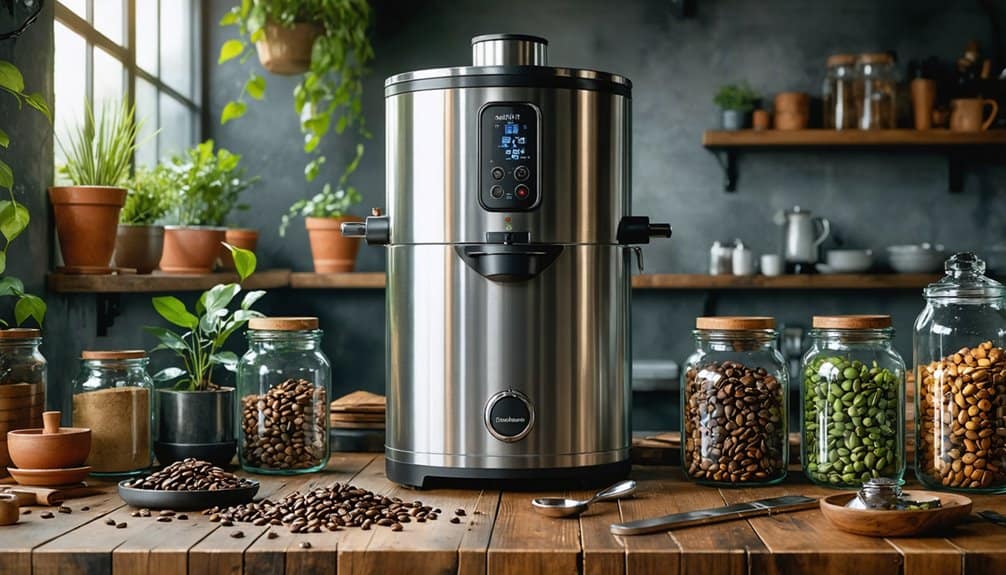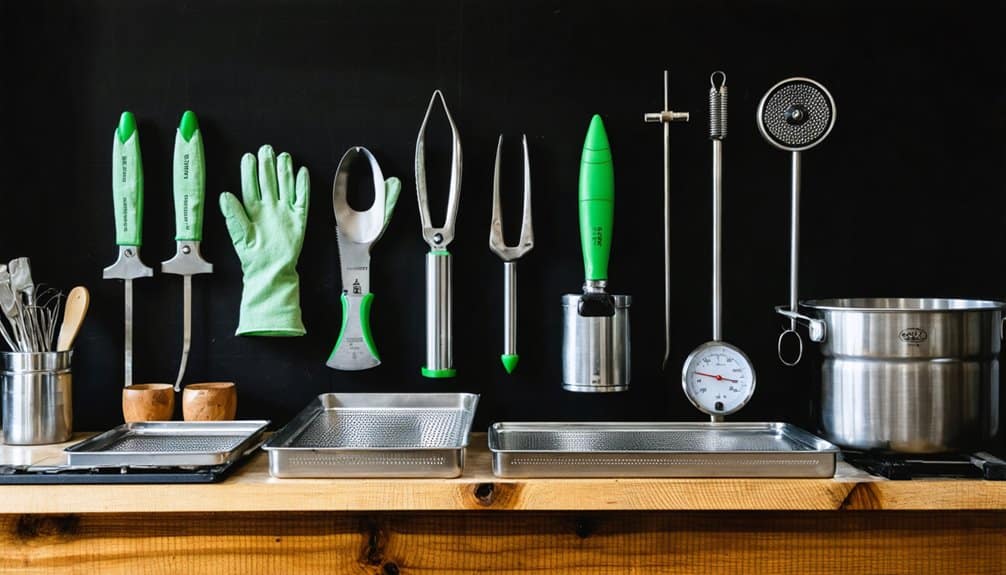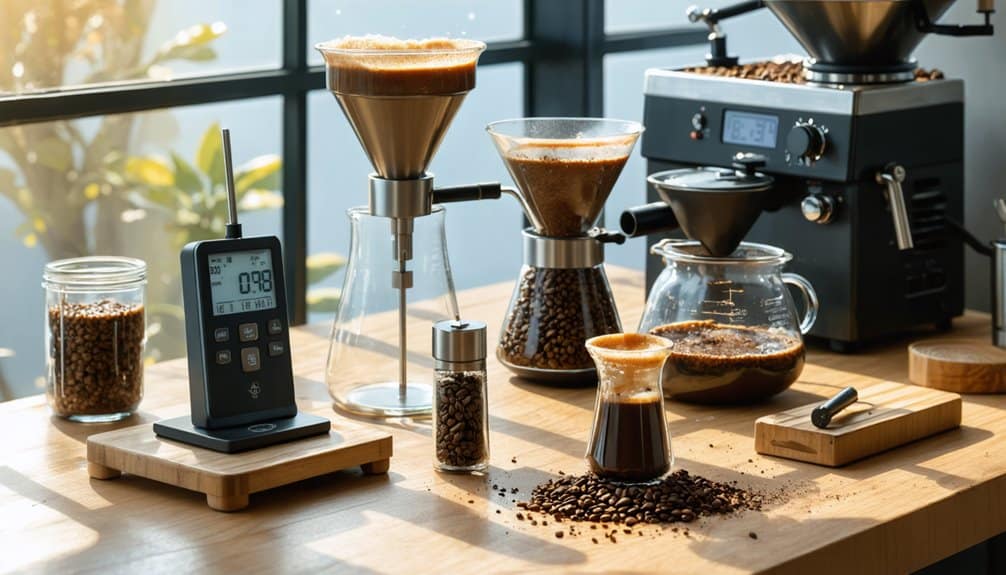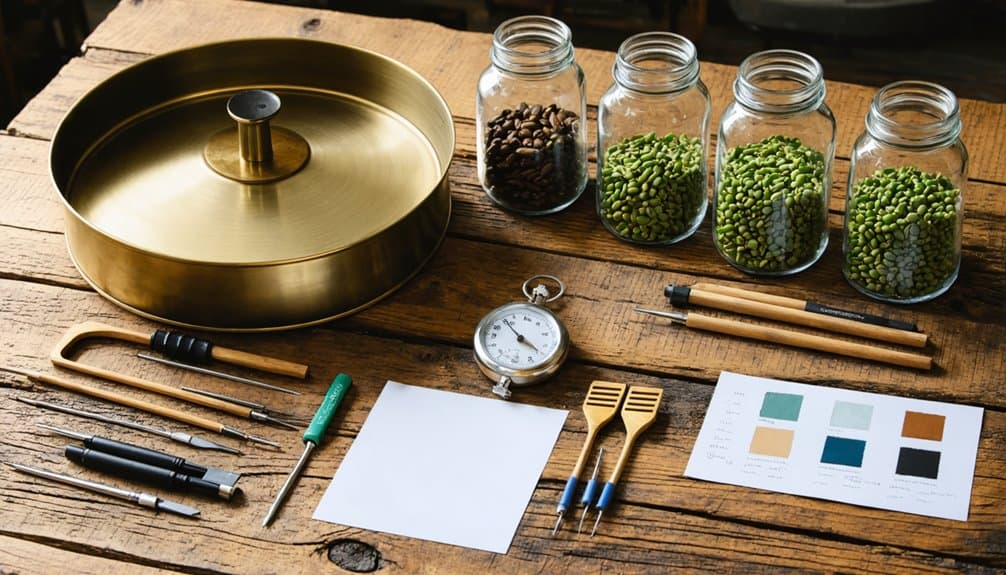You’ll need seven crucial tools to start your coffee roasting expedition: a reliable roaster (either fluid-air bed for small batches or drum roaster for larger capacity), precise digital thermometers for temperature control up to 220°C, heat-resistant gloves rated for 500°F, airtight storage containers with moisture protection, thorough monitoring equipment like color analysis tools, dedicated cleaning supplies including soft brushes and food-safe sanitizers, and digital logging systems for tracking roast profiles.
Understanding these foundational elements will transform your initial roasting attempts into consistently excellent results that rival professional standards.
Key Takeaways
- A reliable coffee roaster (drum or fluid-air bed) with appropriate batch capacity matching your weekly consumption needs.
- Digital thermometers or thermocouples for accurate temperature monitoring up to 220°C during the roasting process.
- Heat-resistant gloves and proper ventilation system to ensure safety while handling hot equipment and managing smoke.
- Airtight storage containers with moisture control to preserve green beans and maintain freshness before roasting.
- Cleaning tools including soft brushes, vacuum system, and chaff collection equipment for maintaining equipment hygiene.
Choosing Your First Coffee Roaster

When diving into the world of coffee roasting, selecting the right equipment stands out as one of the most crucial decisions you’ll make.
You’ll need to choose between two primary types: fluid-air bed roasters and drum roasters. Each offers distinct advantages for your roasting expedition.
Many beginners find success starting with popcorn makers as an entry point.
If you’re starting small, fluid-air bed roasters handle 2.5 to 5 oz. batches, perfect for personal consumption.
For larger needs, drum roasters process 8 to 10 oz., with some models reaching up to 300g per batch.
You’ll want to take into account your weekly coffee consumption and potential growth when selecting capacity.
Key factors include ventilation requirements, control options, and space constraints.
Reflect on whether you prefer manual control over roast profiles or automated functions.
Remember to factor in your budget while accounting for ongoing costs like green beans and maintenance.
Essential Temperature Control Equipment
To achieve precise coffee roasting results, you’ll need accurate temperature monitoring tools like digital thermometers or thermocouples that can measure high temperatures up to 220°C.
Your choice of thermometer directly impacts your ability to track critical temperature milestones during roasting, with digital options offering superior precision compared to traditional analog devices.
Proper heat management also requires understanding how your roaster’s temperature control method works, whether it’s a PID-controlled system for automated precision or manual controls that need constant adjustment based on temperature readings.
PID control systems continuously adjust temperatures within +/- 2°F for consistent batch results.
Thermometers For Precision Roasting
Since precision temperature control lies at the heart of successful coffee roasting, selecting the right thermometer becomes a critical decision for any roaster.
You’ll need to choose between digital, infrared, and probe thermometers, each offering distinct advantages for monitoring your roast progression.
Many roasters incorporate PID control systems that are economical yet provide complete temperature management packages.
| Type | Accuracy | Best Use Case |
|---|---|---|
| Digital | ±0.1°C | Complete Process |
| Infrared | ±2°C | Quick Checks |
| Probe | ±0.5°C | Continuous Monitoring |
| Analog | ±5°C | Backup System |
For ideal results, you’ll want a thermometer that provides readings within the -30°C to 300°C range.
Digital thermometers with LCD displays offer the precision you’ll need, while infrared options give you quick surface temperature readings.
Consider investing in multiple temperature monitoring tools, as experienced roasters often combine different types to guarantee thorough process control.
Heat Management Essentials
Along with temperature monitoring tools, a thorough set of heat management equipment forms the backbone of precise coffee roasting.
You’ll need reliable heat sources and control mechanisms to maintain consistent temperatures throughout your roasting process.
Whether you’re using a stovetop setup with cast iron or a dedicated roaster with PID controls, proper heat management guarantees repeatable results.
Using a cast iron skillet provides excellent heat retention and distribution for more even roasting results.
- Gas burners with adjustable settings for precise heat control and even distribution
- High-quality roasting vessels like heavy-duty pans or dedicated drums with proper agitation systems
- Cooling systems to rapidly stop the roasting process at the desired point
For best results, combine your heat management tools with detailed roast logging and close monitoring of visual and auditory cues.
Pay attention to bean color changes and crack sounds while maintaining consistent airflow and temperature curves throughout each roast.
Safe Handling Tools

You’ll need heat-resistant gloves rated for temperatures up to 500°F to safely handle hot roasting equipment and freshly roasted beans during the cooling process.
Your chaff collection system must include properly maintained filters and collection containers to prevent fine coffee particles from becoming airborne hazards in your workspace.
For clean-up operations, you should equip yourself with specialized vacuum systems designed for coffee chaff and appropriate respiratory protection to guard against dust exposure.
A well-stocked first aid kit should be readily accessible in your roasting area to address any minor burns or injuries that may occur during operations.
Heat-Resistant Gloves Equipment
Heat-resistant gloves represent a crucial safety component in coffee roasting operations, protecting handlers from temperatures ranging from 932°F to 1472°F depending on the material composition.
You’ll want to select gloves that combine high heat resistance with flexibility for handling roasting equipment and green coffee transfers.
When choosing your heat-resistant gloves, prioritize options with extended cuffs and waterproof properties to prevent burns from hot beans or equipment.
Regular cleaning with warm soapy water helps maintain hygiene and performance over time.
- Aramid-based gloves offer superior protection and durability for frequent roasting operations
- Silicone-dotted patterns help dissipate heat faster while maintaining necessary grip control
- Neoprene rubber options with extra-long cuffs provide extensive protection for deep reach into roasting equipment
Consider gloves meeting EN 407 standards with at least Rating 3 (752°F) for professional coffee roasting applications, ensuring both safety and handling precision.
Chaff Collection Systems
Chaff collection systems make up a crucial safety component in coffee roasting operations, incorporating high-performance blowers, cyclone separators, and specialized hoods to manage the lightweight, papery chaff that separates from beans during roasting.
You’ll find both internal and external cyclone options available, with modular designs that allow for flexible installation based on your space requirements.
The all metal construction ensures exceptional durability and minimal maintenance requirements over time.
| System Type | Key Features | Safety Benefits |
|---|---|---|
| Internal Cyclone | Built-in collection | Reduced fire risk |
| External Cyclone | Central barrel storage | Easy maintenance |
| Swing Hood | DIY compatibility | Improved ventilation |
Regular maintenance of your chaff collection system isn’t discretionary—it’s vital for preventing fire hazards and ensuring prime flavor development.
You’ll want to focus on proper filtration and ventilation while keeping all components clean and well-maintained for consistent, high-quality roasts.
Clean-Up Safety Gear
A thorough safety gear setup forms the foundation of any professional coffee roasting operation, incorporating vital protective equipment and handling tools designed specifically for high-temperature environments.
- Heat-resistant gloves rated for continuous exposure to high temperatures
- Industrial-grade tongs and long-handled tools for maintaining safe distance
- Emergency spray bottles and primary aid kits positioned within quick reach
You’ll need to equip your workspace with heat-resistant gloves for handling hot equipment and beans, alongside specialized tongs and spoons that allow precise control while maintaining safety.
Long-handled tools are fundamental for maintaining distance from hot surfaces, reducing burn risks during bean manipulation.
Regular cleaning and organization of your workspace helps prevent accidents and maintains operational efficiency.
Keep emergency spray bottles filled with water readily accessible for immediate cooling if needed, and confirm your primary aid kit remains fully stocked and easily reachable for treating any minor injuries that may occur.
Bean Storage Solutions
Proper storage solutions play a vital role in maintaining coffee bean quality and freshness throughout the roasting process.
You’ll want to invest in airtight containers like Brute Containers or AirScape Coffee Canisters, which protect your beans from moisture, temperature changes, and contaminants. Consider lining your containers with GrainPro bags for additional moisture protection.
Store your beans in a climate-controlled environment between -10°C and 10°C, away from direct light.
You’ll need to maintain relative humidity around 60% using hygrometers for monitoring and dehumidifiers or desiccants for control.
Regular humidity checks are important for preventing mold and mildew development.
For best results, you’ll find that combining durable storage containers with proper environmental controls not only preserves bean quality but also supports sustainable practices by reducing waste and extending bean life.
Roast Monitoring Tools

Reliable monitoring tools form the backbone of successful coffee roasting operations.
You’ll need precise temperature control devices, color analysis instruments, and thorough data logging systems to achieve consistent results.
Modern roasting requires a scientific approach, combining multiple measurement tools to track your roast development.
Quality control tools are essential for both small and large roasters to maintain consistency and optimize flavor development.
- Temperature controllers and thermocouples provide real-time feedback on bean temperature and environmental conditions
- Color analyzers like the Agtron Coffee Meter or Lighttells NIR system help you maintain consistency across batches
- Data logging software integrates time, temperature, and color metrics for detailed roast profiling
Your monitoring setup should include high-temperature thermometers, precise timers, and automated systems that work together.
These tools enable you to track critical parameters, make informed adjustments, and replicate successful roasts with confidence.
Basic Clean-Up Equipment
Clean-up equipment plays a crucial role in maintaining your coffee roaster’s performance and longevity.
You’ll need a soft brush to remove coffee grounds from your roaster and surrounding areas, along with a damp cloth for wiping down the cooling tray and exterior surfaces.
A dedicated waste bin for chaff disposal is critical for keeping your workspace organized.
Don’t overlook the importance of a quality vacuum cleaner – it’s imperative for removing built-up particles and chaff that can affect your roaster’s performance.
You’ll also want to keep food-safe sanitizer on hand for cleaning the hopper.
Regular cleaning helps prevent fire hazards in your roasting operation.
These basic tools form the foundation of your cleaning arsenal and guarantee you’re maintaining professional standards in your roasting operation.
When you properly maintain your equipment, you’re investing in consistent, high-quality roasts.
Roast Documentation Materials

While maintaining a clean roasting environment sets the foundation for success, accurate documentation guarantees your roasting process remains consistent and repeatable.
You’ll need extensive tools to track every aspect of your roasting expedition, from initial bean characteristics to final cup quality.
Sample roasting tests help perfect your techniques before scaling to larger batches.
Your documentation system should include batch tracking protocols, detailed roast profiles, and quality control checklists.
Invest in software that allows for barcode scanning and automated data collection to streamline your process.
Keep certification records and origin logs readily available, and maintain thorough temperature profiles for each roast.
This systematic approach guarantees you’ll achieve consistency while building a valuable database of roasting knowledge.
- Digital logging systems with cloud storage for secure, accessible record-keeping
- Standardized flavor profile sheets and cupping report templates
- Temperature and moisture content tracking tools with automated reporting capabilities
FAQs
How Long Should I Wait Before Grinding Newly Roasted Coffee Beans?
You’ll want to wait 7 days after roasting before grinding your coffee beans, allowing proper degassing and flavor development while maintaining balance between carbon dioxide release and oxidation.
Can I Reuse Green Coffee Beans That Were Previously Frozen?
You can reuse frozen green coffee beans if you properly defrost them for 72-96 hours and store them in airtight containers to prevent moisture. They’ll roast effectively when thawed correctly.
What Causes Some Coffee Beans to Crack Louder During Roasting?
You’ll hear louder cracks when beans have higher moisture content, greater density, and more consistent heat application. Bean size and variety also influence crack intensity during moisture-to-steam conversion.
Does Altitude Affect Home Coffee Roasting Temperatures and Times?
As they say, what goes up must come down. You’ll find that altitude greatly affects your roasting process, requiring lower temperatures and shorter times due to reduced atmospheric pressure and oxygen levels.
Why Do Some Beans Develop Oil Spots While Others Stay Dry?
You’ll notice oil spots develop when heat breaks down your beans’ internal structures during roasting. Darker roasts, naturally processed coffees, and low-density beans are especially prone to releasing oils through their porous surfaces.
The Bottom Line
You’ll find that mastering coffee roasting requires investing in proper equipment from the outset.
While these seven categories of tools may seem like quite the undertaking, they’re crucial for achieving consistent, high-quality results.
Your roasting apparatus, from the humble thermometer to the venerable chaff collector, forms the foundation of your craft.
Consider this carefully curated collection your gateway into the time-honored art of coffee transformation.